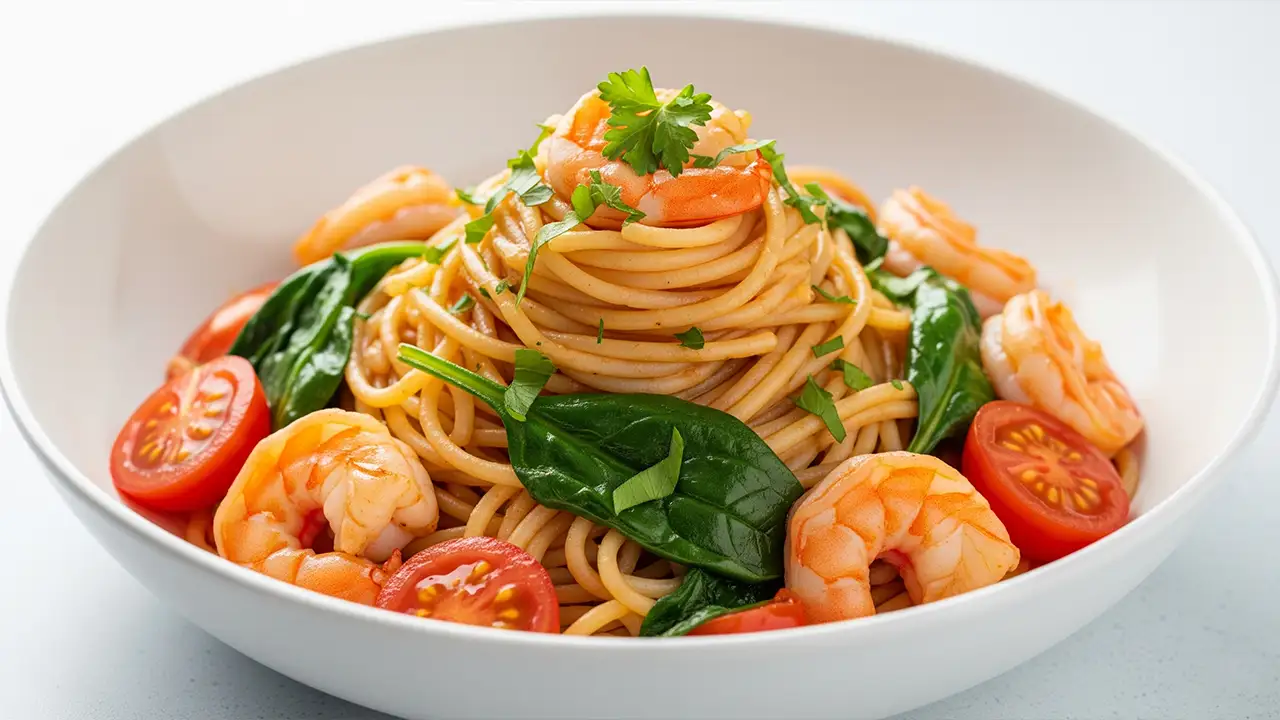
Let’s talk about the food you miss the most. When you’re navigating a new dietary world, it’s often the simple comforts, like a big bowl of pasta, that you grieve for. The fear of triggering symptoms can make the kitchen feel like a minefield, and the “safe” options often taste bland and joyless. I see you. And I’m here to tell you that your search for a delicious, worry-free meal is over. This guide to creating amazing low fodmap pasta recipes is your ticket back to flavor.
This isn’t just a list of ingredients; it’s a new way of thinking about food. It’s a promise that you can have a spectacularly flavorful, comforting, and completely gut-friendly pasta dish that will make you feel amazing. This is the one.
So, let’s get back in the kitchen with joy and confidence. Let’s make a pasta dish that loves you back.
My Quest for Flavor: A Low FODMAP Revelation
My journey into low FODMAP cooking didn’t start with a personal diagnosis, but with a letter from a reader. It was a heartfelt story about her love for food and how her struggle with IBS had forced her to give up cooking for her family. Her world of flavor had shrunk to a few plain ingredients. That letter lit a fire in me. I refused to accept that a dietary restriction had to be a life sentence of blandness, and you can read more about my story about starting the Low FODMAP diet here.
My obsession became a professional challenge: could I apply my deep-dive, systematic approach to the Low FODMAP diet, developed by the brilliant researchers at Monash University? I studied the science of fermentable carbohydrates—the “FODMAPs”—and how they behave in cooking.
My lightbulb moment was a simple one. The low FODMAP diet is not about subtraction; it is about smart and creative substitution. I discovered the magic of creating “ghost” flavors with infused oils and the power of fresh herbs. My quest became to create low fodmap pasta recipes so delicious that anyone would want to eat them, not just those with dietary needs.
What are the 7 Elements of Deliciously Gut-Friendly Pasta?
Crafting truly delicious and gut-friendly pasta is about mastering seven specific elements. Understand these principles, and you’ll unlock a world of flavor.
Element 1: What Are the Best Low FODMAP Pasta Alternatives?
The foundation of our dish must be safe. Choosing a certified low FODMAP, gluten-free pasta is your first step. Pastas made from ingredients (such as rice, corn, and quinoa) are excellent choices. Adhering to the recommended serving size is also critical.
Element 2: How to Build Flavor in Garlic-Free Pasta
This is where we build back the flavor. Garlic-infused olive oil is your new best friend. The fructans in garlic are not oil-soluble, so this process allows the oil to capture the flavor without the FODMAPs. The dark green tops of scallions and leeks provide a fresh, onion-free flavor. Learn more in my complete guide to making and using garlic-infused oil.
Element 3: Using Low FODMAP Vegetable Power
Vegetables add nutrients and texture. We will rely on a delicious roster of safe vegetables. Common choices in appropriate portion sizes include bell peppers, carrots, zucchini, and leafy greens (like spinach and kale). See our list of safe low FODMAP vegetables for more ideas.
Element 4: Choosing Balanced Protein for Your FODMAP Diet Pasta
Protein makes your pasta a satisfying meal. Safe and delicious options include lean meats (like chicken breast and ground beef), seafood (like shrimp), or plant-based options like firm tofu (in certified safe portions).
Element 5: Creating Creamy & Rich Sauce Solutions
You can still have a rich, satisfying sauce! The secret lies in smart swaps. Use lactose-free dairy, the solid cream from a can of chilled full-fat coconut milk, or a simple tomato-based sauce made with canned tomatoes in safe portion sizes. This is key for dairy-free low FODMAP dishes.
Element 6: The Acidity & Umami Boost
To make flavors pop, you need balance. A squeeze of fresh lemon juice at the end provides a critical burst of acidity. For a cheesy, savory, “umami” flavor, nutritional yeast is a fantastic secret weapon.
Element 7: Mindful Seasoning & Garnishes
The final touches make all the difference. Season your dish well with salt and pepper. A pinch of red pepper flakes can add warmth. A shower of fresh, low FODMAP herbs (like basil, parsley, or chives) just before serving adds immense freshness to your healthy pasta recipes.
How to Cook Perfect Low FODMAP Pasta Every Time
Now, let’s put all 7 elements into practice. Approaching this with a calm focus ensures a delicious, gut-friendly result.
- Build the Flavor Base: Begin by heating your garlic-infused oil in a pan. This is where you’ll bloom your spices and sauté your proteins and heartier vegetables.
- Cook the Pasta: Cook your certified gluten-free low FODMAP pasta in generously salted water. Gluten-free pasta can be tricky; it goes from underdone to mushy very quickly. Cook it only until it is truly al dente.
- Reserve Pasta Water: Just before you drain the pasta, scoop out a cup of the starchy pasta water. This is your key to creating a sauce that clings perfectly.
- Build the Sauce: While the pasta cooks, finish building your sauce in the pan, adding your safe tomato products or creamy elements.
- Combine and Emulsify: Drain the hot pasta and add it directly to the pan with your sauce. Add a splash of the reserved hot pasta water and toss everything together to create a creamy sauce.
Your Low FODMAP Pasta Troubleshooting Guide
Even with a perfect blueprint, issues can arise. This guide helps you diagnose any problems with your low fodmap pasta recipes.
| The Problem | The Likely Cause(s) (Element Failure) | The Foolproof Solution |
| My pasta tastes bland. | Failure in Element 2, 6 or 7. (Not enough aromatics, acidity, or seasoning). | Be generous with garlic-infused oil and the green tops of scallions. Finish the dish with a squeeze of lemon juice and fresh herbs. Salt your pasta water properly. |
| I had digestive upset after eating. | FODMAP “stacking” or incorrect portion sizes. | Double-check your ingredient portion sizes using a reliable app like the one from Monash University. Even safe foods can trigger symptoms in large quantities. |
| My gluten-free pasta is mushy. | Overcooking the pasta, or not rinsing it when appropriate. | Cook gluten-free pasta only until al dente. Some brands benefit from a quick rinse in hot water after draining to remove excess starch. Check package directions. |
| The sauce is watery. | Used a thin tomato sauce or a low-fat cream substitute. | Use canned tomato purée or crushed tomatoes instead of diced. Allow the sauce to simmer for an extra 5-10 minutes to thicken. Use full-fat coconut cream for dairy-free sauces. |
| The dish lacks an “Italian” flavor. | Missing the depth from garlic and onion. | Use high-quality garlic-infused oil. Incorporating dried oregano during cooking and fresh basil at the end will help build that classic flavor profile in your garlic-free pasta. |
Export to Sheets
Frequently Asked Questions (FAQ)
- What are the best low FODMAP pasta brands? Brands vary by region, but look for certified low FODMAP products made from brown rice, quinoa, or corn. Many brands like Jovial and Barilla have excellent gluten-free options.
- Can I really not use garlic powder on a low FODMAP diet? Correct. Garlic powder is made from dehydrated garlic and is very high in fructans. You must avoid it. Stick to garlic-infused oil for flavor.
- How do I make a creamy sauce without dairy? The thick, solid cream from the top of a chilled can of full-fat coconut milk is an excellent base for a dairy-free low FODMAP sauce.
- Can I meal prep low FODMAP pasta? Yes. Cook the sauce and protein ahead of time. Store the cooked pasta separately. Gluten-free pasta is best when cooked fresh, but you can reheat it by tossing it with the sauce and a splash of water.
- What other ingredients should I watch out for? Be careful with processed sauces and broths, which often contain hidden garlic and onion powder. See my full list of high FODMAP foods to avoid.
The Ultimate Low FODMAP Pasta Recipe
- Prep time: 10 minutes
- Cook time: 15 minutes
- Yields: 4 servings
- Equipment Needed: Large pot, large skillet
Ingredients
- 12 oz (340g) certified low FODMAP gluten-free spaghetti or fettuccine
- 3 tablespoons garlic-infused olive oil
- 1 lb (450g) large shrimp, peeled and deveined
- ½ teaspoon red pepper flakes (optional)
- Salt and freshly ground black pepper, to taste
- 1 pint (about 2 cups) cherry tomatoes, halved
- ¼ cup low FODMAP chicken broth
- 2 tablespoons fresh lemon juice
- 2 large handfuls of fresh spinach
- ¼ cup chopped fresh parsley, plus more for garnish
Instructions
- Cook Pasta: Bring a large pot of generously salted water to a boil. Cook the gluten-free pasta according to package directions until al dente.
- Reserve Pasta Water: Before draining, carefully scoop out and reserve about 1 cup of the starchy pasta water. Drain the pasta.
- Season & Cook Shrimp: While pasta cooks, pat the shrimp completely dry and season with salt and pepper. Heat the garlic-infused olive oil in a large skillet over medium-high heat. Add the shrimp in a single layer and cook for 1-2 minutes per side, until pink and opaque. Remove the shrimp and set aside.
- Build the Sauce: Add the red pepper flakes (if using) to the same skillet and toast for 30 seconds. Add the halved cherry tomatoes and a pinch of salt. Cook, stirring occasionally, for 5-7 minutes, until the tomatoes begin to break down.
- Deglaze Pan: Pour in the low FODMAP chicken broth to deglaze the pan, scraping up any flavorful browned bits from the bottom. Let it simmer for 2 minutes.
- Combine Components: Return the cooked shrimp to the skillet. Add the drained pasta, the fresh spinach, and the chopped parsley.
- Emulsify Sauce: Add ¼ cup of the reserved hot pasta water. Toss everything vigorously with tongs. The heat will wilt the spinach and the starchy water will create a light, glossy sauce.
- Adjust & Finish: Add more pasta water, a tablespoon at a time, until the sauce beautifully coats the pasta. Remove from heat and stir in the fresh lemon juice.
- Serve: Taste and adjust seasoning with more salt and pepper. Serve this IBS pasta recipe immediately, garnished with more fresh parsley.
Nutritional Profile (Approximate Values Per Serving)
- Calories: 550 kcal
- Protein: 32g
- Fat: 18g
- Carbohydrates: 68g
- Fiber: 6g
- Sugar: 5g
